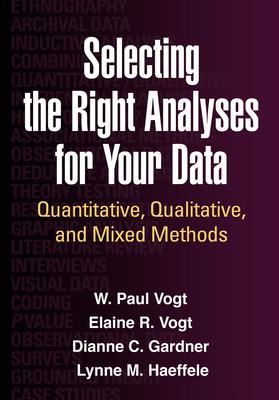| FindBook |
有 1 項符合
Selecting the Right Analyses for Your Data: Quantitative, Qualitative, and Mixed Methods的圖書 |
 |
Selecting the Right Analyses for Your Data: Quantitative, Qualitative, and Mixed Methods 作者:Vogt, W. Paul/ Vogt,Elaine R./Gardner,Dianne C./Haeffele,Lynne M. 出版社:Guilford Pubn 出版日期:2014-07-01 語言:英文 規格:精裝 / 19.7 x 27.3 x 3.8 cm / 普通級 |
| 圖書館借閱 |
| 國家圖書館 | 全國圖書書目資訊網 | 國立公共資訊圖書館 | 電子書服務平台 | MetaCat 跨館整合查詢 |
| 臺北市立圖書館 | 新北市立圖書館 | 基隆市公共圖書館 | 桃園市立圖書館 | 新竹縣公共圖書館 |
| 苗栗縣立圖書館 | 臺中市立圖書館 | 彰化縣公共圖書館 | 南投縣文化局 | 雲林縣公共圖書館 |
| 嘉義縣圖書館 | 臺南市立圖書館 | 高雄市立圖書館 | 屏東縣公共圖書館 | 宜蘭縣公共圖書館 |
| 花蓮縣文化局 | 臺東縣文化處 |
|
|
圖書介紹 - 資料來源:博客來 評分:
圖書名稱:Selecting the Right Analyses for Your Data: Quantitative, Qualitative, and Mixed Methods
內容簡介
"What are the most effective methods to code and analyze data for a particular study? This thoughtful and engaging book reviews the selection criteria for coding and analyzing any set of data--whether qualitative, quantitative, mixed, or visual. The authors systematically explain when to use verbal, numerical, graphic, or combined codes, and when to use qualitative, quantitative, graphic, or mixed-methods modes of analysis. Chapters on each topic are organized so that researchers can read them sequentially or can easily "flip and find" answers to specific questions. Nontechnical discussions of cutting-edge approaches--illustrated with real-world examples--emphasize how to choose (rather than how to implement) the various analyses. The book shows how using the right analysis methods leads to more justifiable conclusions and more persuasive presentations of research results. Useful features for teaching or self-study: *Chapter-opening preview boxes that highlight useful topics addressed. *End-of-chapter summary tables recapping the 'dos and don'ts' and advantages and disadvantages of each analytic technique. *Annotated suggestions for further reading and technical resources on each topic. Subject Areas/Keywords: analyses, coding, combined methods, data analysis, data collection, dissertation, graphical, interpretation, mixed methods, qualitative, quantitative, research analysis, research designs, research methods, social sciences, thesis, visual Audience: Researchers, instructors, and graduate students in a range of disciplines, including psychology, education, social work, sociology, health, and management; administrators and managers who need to make data-driven decisions"--
|








![114年會計學概要[主題式題庫+歷年試題][記帳士] 114年會計學概要[主題式題庫+歷年試題][記帳士]](https://media.taaze.tw/showLargeImage.html?sc=14100121138)
